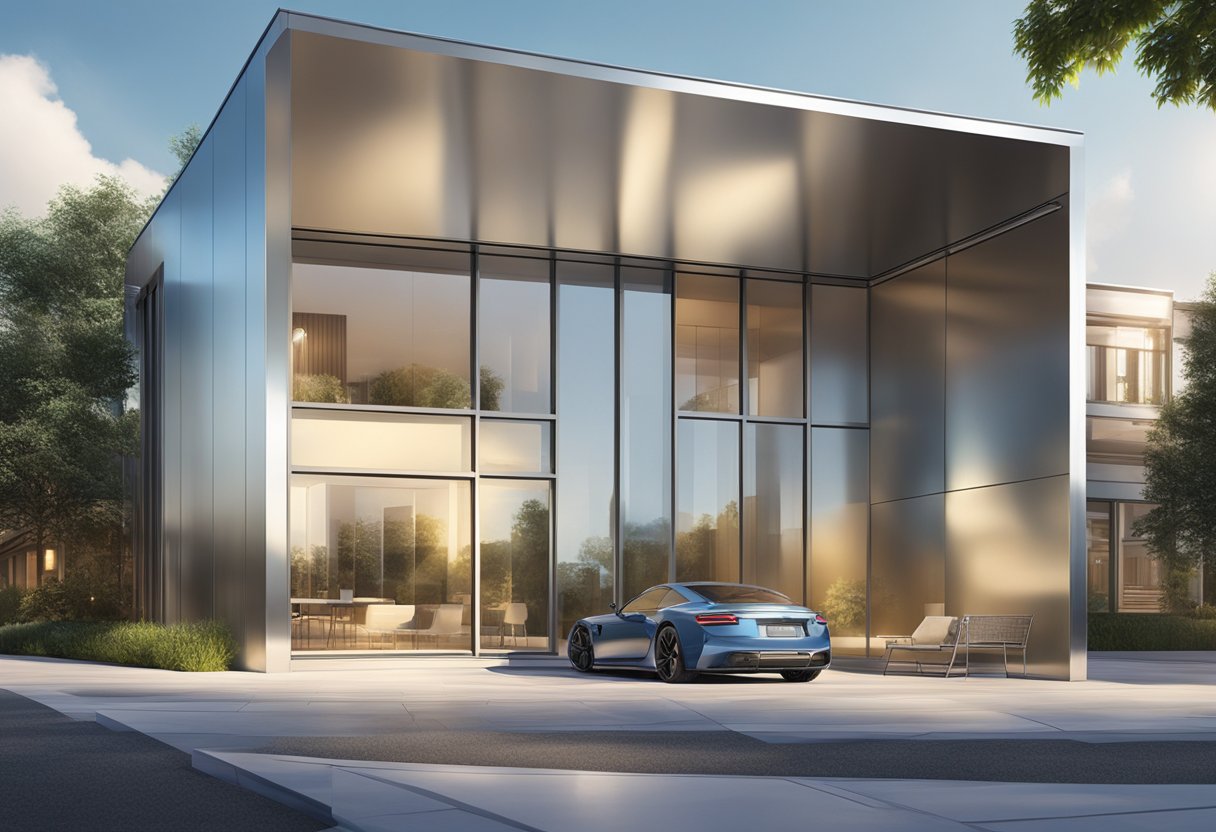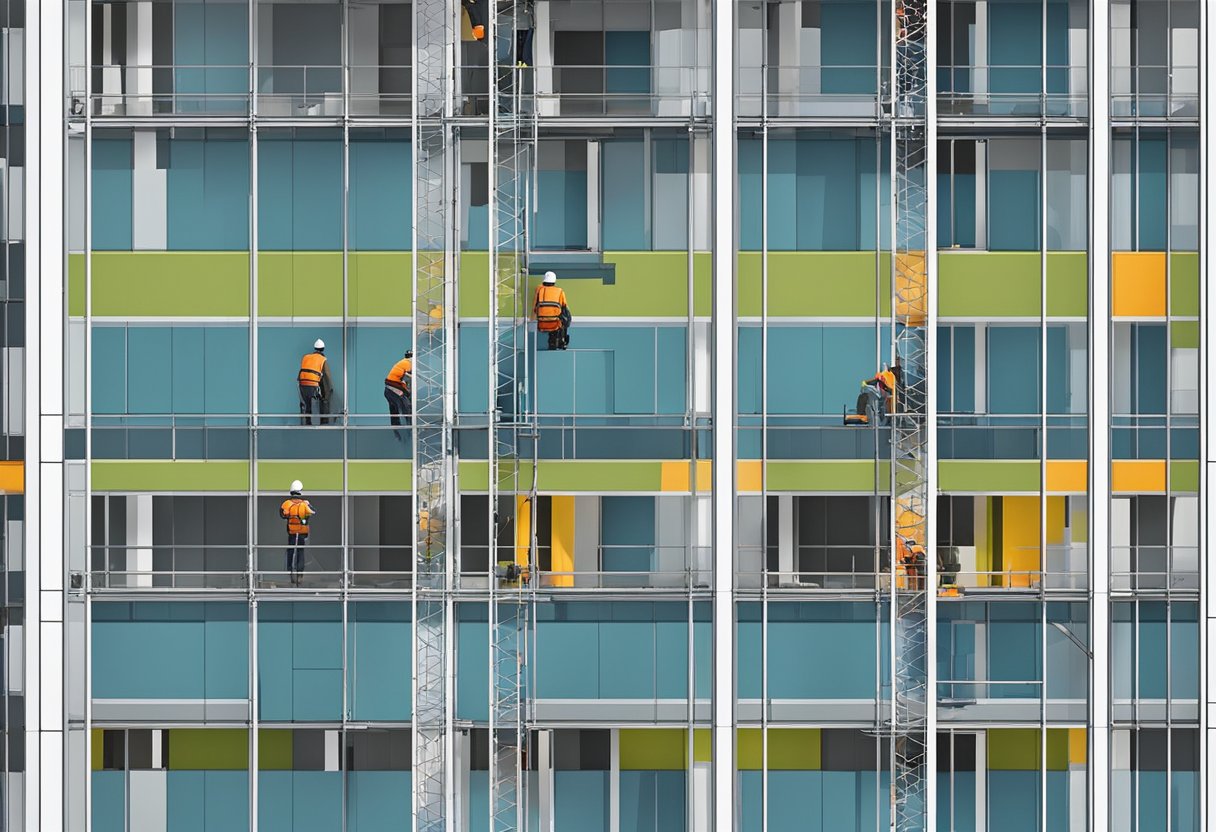Exterior aluminum panels have become a popular choice for modern building facades due to their durability, versatility, and aesthetic appeal. These panels are made of lightweight aluminum sheets that are coated with a protective layer to resist corrosion, weathering, and fading. They can be fabricated into various sizes, shapes, and colors to create a unique and striking appearance for any building.

Aluminum panels offer several advantages over other exterior cladding materials, such as brick, stone, and wood. They are easy to install, maintain, and replace, which can save time and money in the long run. They also provide excellent insulation and soundproofing properties, which can improve the energy efficiency and comfort of a building. Additionally, aluminum panels are recyclable and eco-friendly, making them a sustainable choice for environmentally conscious projects.
Overall, exterior aluminum panels offer a practical and stylish solution for modern building design. With their durability, versatility, and sustainability, they are a popular choice for architects, builders, and property owners alike.
History and Development of Exterior Aluminum Panels

Exterior aluminum panels have been used in construction for several decades. The development of these panels started in the 1960s and 1970s when architects and builders started looking for new materials to use in construction.
The first aluminum panels were made from solid aluminum sheets. These panels were heavy and difficult to install. However, they were durable and had a long lifespan. Over time, manufacturers started producing aluminum panels with a honeycomb core. These panels were much lighter and easier to install.
In the 1980s, manufacturers started producing aluminum panels with a polyethylene core. These panels were even lighter and more affordable than the previous versions. They also had better insulation properties.
Today, exterior aluminum panels are available in a wide range of colors and finishes. They can be used in a variety of applications, including commercial and residential buildings. They are also popular in the construction of high-rise buildings because of their durability and fire resistance.
Overall, the development of exterior aluminum panels has been driven by the need for lightweight, durable, and affordable building materials. As technology continues to advance, it is likely that we will see even more innovative uses for aluminum panels in construction.
Types of Exterior Aluminum Panels
Anodized Aluminum Panels
Anodized aluminum panels are created through an electrochemical process that enhances the natural oxide layer on the surface of the aluminum. This process creates a durable and corrosion-resistant finish that is available in a variety of colors. Anodized aluminum panels are known for their ability to maintain their color and finish over time, even in harsh outdoor environments.
Painted Aluminum Panels
Painted aluminum panels are coated with a layer of paint to create a specific color and finish. The paint provides a layer of protection against the elements, but it can fade or chip over time. Painted aluminum panels are available in a wide range of colors and finishes, making them a versatile option for exterior cladding.
Coated Aluminum Panels
Coated aluminum panels are created by applying a layer of protective coating to the surface of the aluminum. The coating can be made from a variety of materials, including polyvinylidene fluoride (PVDF) and polyester. Coated aluminum panels are known for their durability and resistance to fading, chalking, and cracking. They are available in a range of colors and finishes, making them a popular choice for modern building designs.
In summary, there are several types of exterior aluminum panels available for use in building design. Anodized aluminum panels provide a durable and long-lasting finish, while painted aluminum panels offer a wide range of color options. Coated aluminum panels offer superior protection against the elements and are available in a variety of finishes. Each type has its own unique benefits and can be used to create a variety of building designs.
Manufacturing Processes
Extrusion
Extrusion is a common manufacturing process used to create aluminum panels. In this process, a heated aluminum billet is pushed through a die to create a desired shape. The resulting aluminum panel is then cooled and cut to the desired length. Extrusion is a versatile process that can be used to create panels with a variety of shapes and sizes.
Roll Forming
Roll forming is another common manufacturing process used to create aluminum panels. In this process, a flat aluminum sheet is fed through a series of rollers that gradually bend the sheet into the desired shape. Roll forming is ideal for creating panels with a consistent shape and size, and can be used to create panels with complex shapes.
Fabrication
Fabrication is the process of cutting, drilling, and assembling aluminum panels into a finished product. This process can be done manually or with the use of computer-controlled machinery. Fabrication is a critical step in the manufacturing process as it ensures that the panels are cut and assembled to the correct specifications.
Overall, the manufacturing process for exterior aluminum panels is a complex and precise process that requires skilled technicians and specialized equipment. By using a combination of extrusion, roll forming, and fabrication, manufacturers can create high-quality aluminum panels that are both durable and aesthetically pleasing.
Installation Techniques
Mechanical Fastening
Mechanical fastening is a popular method for installing exterior aluminum panels. It involves securing the panels to the substrate using mechanical fasteners such as screws, rivets, or bolts. This method is suitable for both new construction and retrofitting existing buildings. Mechanical fastening provides a secure and durable attachment and allows for easy removal and replacement of damaged panels.
When using mechanical fasteners, it is essential to ensure that the substrate is strong enough to support the weight of the panels. The fasteners should be installed at the recommended spacing and torque to prevent overloading and damage to the panels. It is also important to use compatible fasteners and sealants to prevent galvanic corrosion.
Adhesive Bonding
Adhesive bonding is another installation method for exterior aluminum panels. It involves using a high-strength adhesive to attach the panels to the substrate. This method provides a seamless and aesthetically pleasing finish, as there are no visible fasteners or joints. Adhesive bonding is suitable for flat and curved surfaces and allows for flexibility in design.
When using adhesive bonding, it is essential to prepare the substrate properly to ensure a strong bond. The surface should be clean, dry, and free of dust, grease, and other contaminants. The adhesive should be applied at the recommended thickness and temperature to achieve the desired bond strength. It is also important to use a compatible adhesive and primer to prevent delamination and failure.
Welding
Welding is a less common installation method for exterior aluminum panels. It involves fusing the panels to the substrate using heat and pressure. This method provides a strong and durable attachment and allows for easy removal and replacement of damaged panels. Welding is suitable for large panels and complex shapes and allows for flexibility in design.
When using welding, it is essential to ensure that the substrate and panels are compatible and can withstand the heat and pressure of the welding process. The welds should be inspected for defects and repaired as necessary to ensure a strong and durable attachment. It is also important to follow the recommended welding procedures and safety precautions to prevent injury and damage to the panels.
Maintenance and Durability
Cleaning
Exterior aluminum panels are easy to maintain and require minimal cleaning. Regular cleaning is important to prevent the buildup of dirt and debris. The panels can be cleaned with a mild detergent and water solution. Avoid using abrasive cleaners or scrubbers as they can scratch the surface of the panels. Rinse the panels thoroughly with clean water after cleaning to remove any residue.
Repair
Aluminum panels are durable and resistant to damage, but if they do get damaged, they can be repaired easily. Small scratches or dents can be fixed with touch-up paint, while larger damages may require professional repair. It is important to address any damages as soon as possible to prevent further damage and maintain the appearance of the panels.
Lifespan
Aluminum panels are known for their durability and long lifespan. With proper maintenance and care, they can last for many years without showing signs of wear and tear. The lifespan of the panels can vary depending on the quality of the material and the installation. It is important to choose high-quality panels and have them installed by a professional to ensure maximum durability and longevity.
Environmental Impact and Sustainability
Recycling and Reuse
Aluminum panels are highly recyclable and can be reused in a variety of applications. In fact, aluminum is one of the most recycled materials in the world, with over 75% of all aluminum ever produced still in use today. Recycling aluminum panels not only reduces waste but also saves energy, as it takes significantly less energy to recycle aluminum than to produce it from raw materials.
Additionally, aluminum panels can be reused in other construction projects. This can be done by salvaging panels from existing buildings or by repurposing panels from one project to another. This reduces the need for new materials and further reduces waste.
Energy Efficiency
Aluminum panels are known for their energy efficiency. They are excellent at reflecting sunlight, which can help reduce the amount of heat that enters a building. This, in turn, can reduce the amount of energy needed to cool the building.
Moreover, aluminum panels are lightweight and easy to install, which reduces the amount of energy needed for transportation and installation. This is because less fuel is needed to transport lightweight materials, and less equipment and labor are needed to install them.
Overall, aluminum panels are a sustainable and environmentally friendly option for exterior cladding. Their recyclability and energy efficiency make them an excellent choice for those seeking to reduce their environmental impact.



